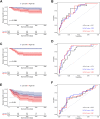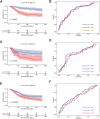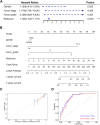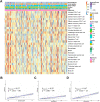Identification of a Hypoxia-Related Signature for Predicting Prognosis and the Immune Microenvironment in Bladder Cancer
- PMID: 34026819
- PMCID: PMC8138130
- DOI: 10.3389/fmolb.2021.613359
Identification of a Hypoxia-Related Signature for Predicting Prognosis and the Immune Microenvironment in Bladder Cancer
Abstract
Accumulating evidence indicates that hypoxia is highly associated with bladder cancer genesis, progression, and immune microenvironment. Nevertheless, few studies have identified the role of hypoxia-related genes as a prognostic signature in bladder cancer. This study aimed to establish a hypoxia-related signature with high accuracy for prognosis and immune microenvironment prediction in bladder cancer. We obtained expression profiles and clinical information from Gene Expression Omnibus and The Cancer Genome Atlas. Then the univariate Cox regression, random survival forest algorithm, and multivariate Cox regression analysis were conducted to identify the core genes and four hypoxia-related genes (ANXA2, GALK1, COL5A1, and HS3ST1) were selected to construct the signature. Kaplan-Meier survival analysis demonstrated that patients with a low-risk score had a higher disease-specific survival rate (p < 0.0001). The areas under the curve of the signature were 0.829 at 1 year, 0.869 at 3 years, and 0.848 at 5 years, respectively. Additionally, we found this hypoxia-related signature was highly correlated with tumor immune microenvironment and had the potential to predict the efficacy of immunotherapy. In summary, our study developed a hypoxia-related signature, which had high accuracy for prognosis prediction and the potential to guide the immunotherapy for bladder cancer patients.
Keywords: bladder cancer; disease-specific survival; hypoxia; immune microenvironment; signature.
Copyright © 2021 Jiang, Ren, Chen, Wang, Wu, Cheng, Li and Yu.
Conflict of interest statement
The authors declare that the research was conducted in the absence of any commercial or financial relationships that could be construed as a potential conflict of interest.
Figures










Similar articles
-
Identifying a hypoxia related score to predict the prognosis of bladder cancer: a study with The Cancer Genome Atlas (TCGA) database.Transl Androl Urol. 2021 Dec;10(12):4353-4364. doi: 10.21037/tau-21-569. Transl Androl Urol. 2021. PMID: 35070817 Free PMC article.
-
Identification and validation of a hypoxia-related prognostic and immune microenvironment signature in bladder cancer.Cancer Cell Int. 2021 May 7;21(1):251. doi: 10.1186/s12935-021-01954-4. Cancer Cell Int. 2021. PMID: 33962639 Free PMC article.
-
A novel hypoxia- and lactate metabolism-related signature to predict prognosis and immunotherapy responses for breast cancer by integrating machine learning and bioinformatic analyses.Front Immunol. 2022 Oct 7;13:998140. doi: 10.3389/fimmu.2022.998140. eCollection 2022. Front Immunol. 2022. PMID: 36275774 Free PMC article.
-
A Hypoxia Signature for Predicting Prognosis and Tumor Immune Microenvironment in Adrenocortical Carcinoma.J Oncol. 2021 Sep 21;2021:2298973. doi: 10.1155/2021/2298973. eCollection 2021. J Oncol. 2021. PMID: 34603443 Free PMC article.
-
Bioinformatics Analysis Finds Immune Gene Markers Related to the Prognosis of Bladder Cancer.Front Genet. 2020 Jun 23;11:607. doi: 10.3389/fgene.2020.00607. eCollection 2020. Front Genet. 2020. PMID: 32655621 Free PMC article.
Cited by
-
Identification of a Nuclear Mitochondrial-Related Multi-Genes Signature to Predict the Prognosis of Bladder Cancer.Front Oncol. 2021 Oct 6;11:746029. doi: 10.3389/fonc.2021.746029. eCollection 2021. Front Oncol. 2021. PMID: 34692528 Free PMC article.
-
Integrative multi-omics analysis for identifying novel therapeutic targets and predicting immunotherapy efficacy in lung adenocarcinoma.Cancer Drug Resist. 2025 Jan 14;8:3. doi: 10.20517/cdr.2024.91. eCollection 2025. Cancer Drug Resist. 2025. PMID: 39935429 Free PMC article.
-
Development and experimental verification of a prognosis model for hypoxia- and lactate metabolism-associated genes in HNSCC.Medicine (Baltimore). 2025 Jun 13;104(24):e42665. doi: 10.1097/MD.0000000000042665. Medicine (Baltimore). 2025. PMID: 40527790 Free PMC article.
-
Identifying a hypoxia related score to predict the prognosis of bladder cancer: a study with The Cancer Genome Atlas (TCGA) database.Transl Androl Urol. 2021 Dec;10(12):4353-4364. doi: 10.21037/tau-21-569. Transl Androl Urol. 2021. PMID: 35070817 Free PMC article.
-
Multilevel plasticity and altered glycosylation drive aggressiveness in hypoxic and glucose-deprived bladder cancer cells.iScience. 2025 Jan 4;28(2):111758. doi: 10.1016/j.isci.2025.111758. eCollection 2025 Feb 21. iScience. 2025. PMID: 39906564 Free PMC article.
References
LinkOut - more resources
Full Text Sources
Other Literature Sources
Miscellaneous

